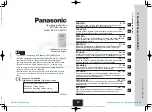FXTH870xD
Sensors
Freescale Semiconductor, Inc.
13
Specific to the tire pressure monitoring application the parameter registers and the LFO with wakeup timer are powered up at all
times whenever voltage is applied to the supply pins. The LFR detector and MFO may be periodically powered up by the LFR
decoder.
3.5.3
Active BDM Enabled in STOP Mode
Entry into the ACTIVE BACKGROUND DEBUG mode from RUN mode is enabled if the ENBDM bit in BDCSCR is set. The
BDCSCR register is not memory mapped so it can only be accessed through the BDM interface by use of the BDM commands
READ_STATUS and WRITE_CONTROL. If ENBDM is set when the CPU executes a STOP instruction, the system clocks to the
BACKGROUND DEBUG logic remain active when the MCU enters STOP mode so BACKGROUND DEBUG communication is
still possible. In addition, the voltage regulator does not enter its low-power standby state but maintains full internal regulation. If
the user attempts to enter the STOP1 with ENDBM set, the MCU will instead enter this mode which is STOP4 with system clocks
running.
Most BACKGROUND commands are not available in STOP mode. The memory-access-with-status commands do not allow
memory access, but they report an error indicating that the MCU is in STOP mode. The BACKGROUND command can be used
to wake the MCU from stop and enter ACTIVE BACKGROUND mode if the ENDBM bit is set. Once in BACKGROUND DEBUG
mode, all BACKGROUND commands are available.
3.5.4
MCU On-Chip Peripheral Modules in STOP Modes
When the MCU enters any STOP mode, system clocks to the internal peripheral modules except the wakeup timer and LFR
detectors/decoder are stopped. Even in the exception case (ENDBM = 1), where clocks are kept alive to the BACKGROUND
debug logic, clocks to the peripheral systems are halted to reduce power consumption.
I/O Pins
If the MCU is configured to go into STOP1 mode, the I/O pins are forced to their default reset state (Hi-Z) upon entry into stop.
This means that the I/O input and output buffers are turned off and the pullup is disconnected.
Memory
All module interface registers will be reset upon wakeup from STOP1 and the contents of RAM are not preserved. The MCU must
be initialized as upon reset. The contents of the FLASH memory are non-volatile and are preserved in any of the STOP modes.
Parameter Registers
The 64 bytes of parameter registers are kept active in all modes of operation as long as power is applied to the supply pins. The
contents of the parameter registers behave like RAM and are unaffected by any reset.
LFO
The LFO remains active regardless of any mode of operation.
MFO
The medium frequency oscillator (MFO) will remain powered up when the MCU enters the STOP mode only when the SMI has
been initiated to make a pressure or acceleration measurement; or when the RF transmitter’s state machine is processing data.
HFO
The HFO is halted in all STOP modes.
PWU
The PWU remains active regardless of any mode of operation.
Regulator
Off
On
I/O Pins
Hi-Z
States Held
Wakeup Methods
Interrupts, resets
Interrupts, resets
1. RTI can be used in STOP1 or STOP4 if the clock selected is the LFO. To use the HFO as the clock the MCU must be in the RUN mode.
2. MFO oscillator started if the LFR detectors are periodically sampled, the LFR detectors detect an input signal; a pressure or acceleration
reading is in progress or the RF state machine is sending data.
3. Requires internal ADC10 clock to be enabled.
4. Period of sampling set by MCU.
5. RF data buffer may be set up to run while the CPU is in the STOP modes.
Table 1. STOP Mode Behavior (continued)
Mode
STOP1
STOP4
Summary of Contents for FXTH870 D Series
Page 86: ...FXTH870xD Sensors 84 Freescale Semiconductor Inc Figure 57 Data Flow For Measurements...
Page 171: ...FXTH870xD Sensors Freescale Semiconductor Inc 169 Figure 128 QFN Case Outline...
Page 172: ...FXTH870xD Sensors 170 Freescale Semiconductor Inc Figure 129 QFN Case Outline...
Page 173: ...FXTH870xD Sensors Freescale Semiconductor Inc 171...


















